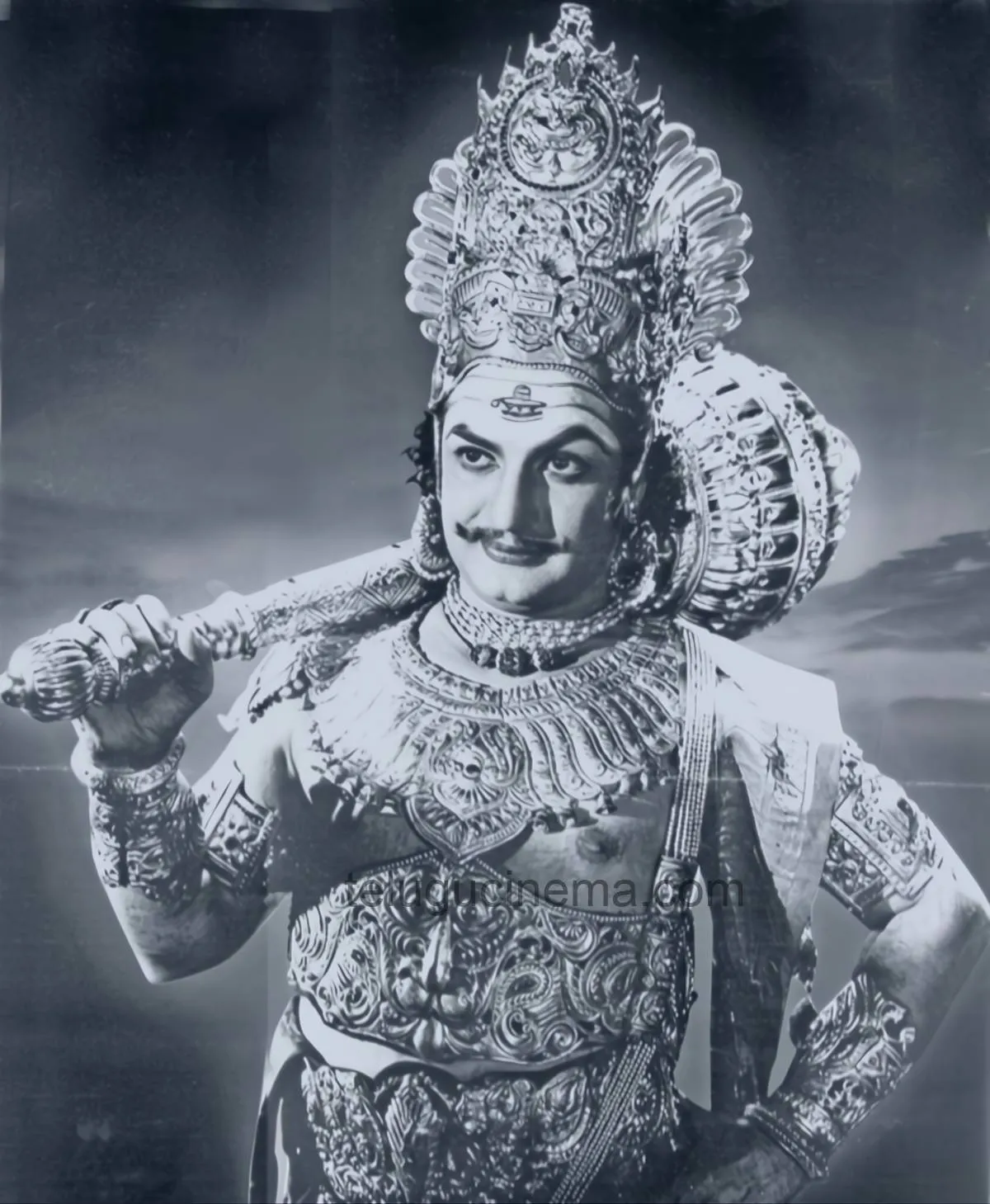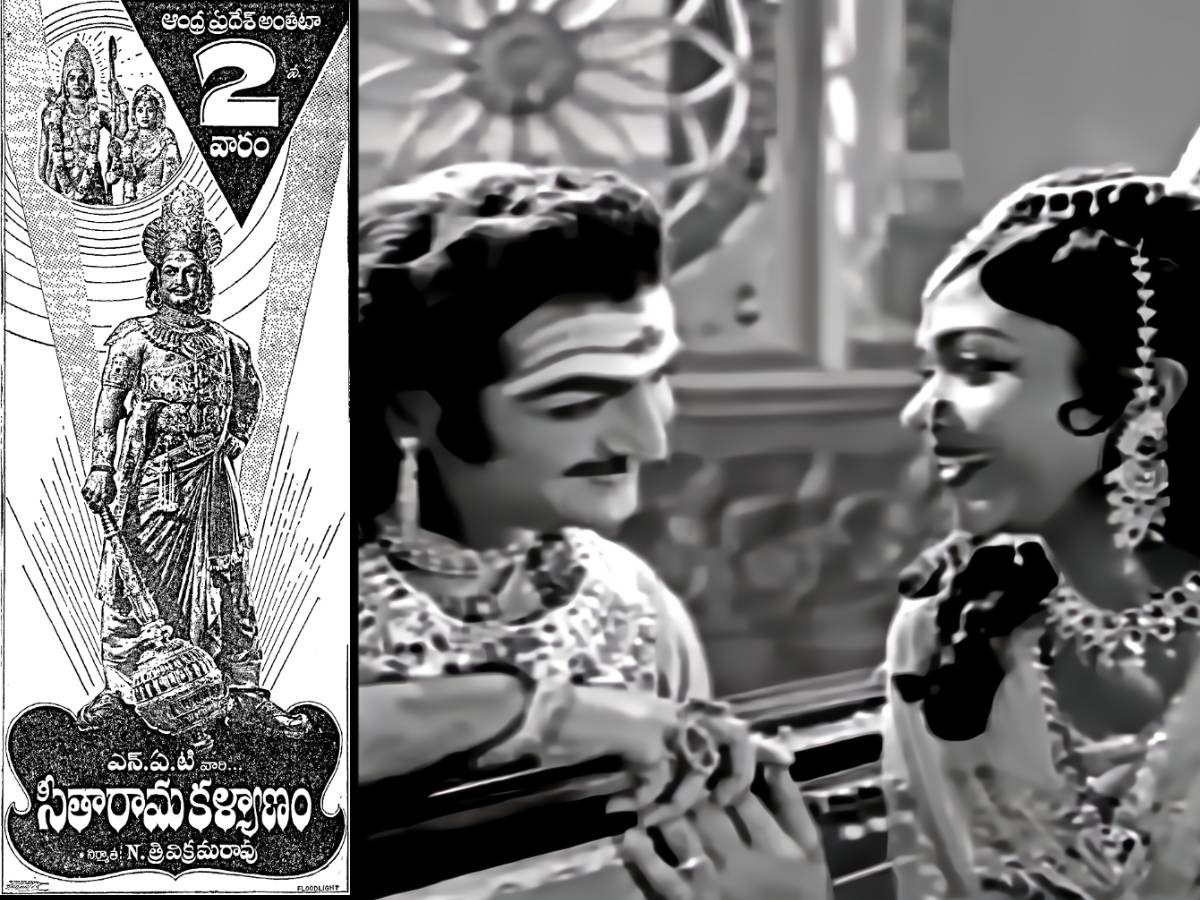
35 MM / Black and White / Duration : 3 hours / Release: Jan 6, 1961
NTR’s “Sita Rama Kalyanam” aka “Sethaa Rama Kalyanam” premiered on January 6, 1961. On the brink of the 65th anniversary of its release, we at Telugucinema.com publish a retrospective piece. We are reproducing this article from our archives, incorporating the necessary modifications and updates. Read on…
Story:
This story revolves around Ravana, a scholar and outstanding musician who is also a devotee of Lord Shiva. His desire for attractive women led to his failure. Ravana, who pleases Lord Shiva with his prayers, receives a boon that makes him invincible. He is unbeatable by any human being. Lord Vishnu, joined by Mahalaxmi, takes on the avatars of Rama and Sita to protect humanity.
About the film
Following the popularity and success of “Mayabazar” (1957), NT Ramarao grew interested in mythological characters. He studied several versions of the Ramayana, Mahabharata, and Bhagavatam. In addition to his portrayals as Lord Krishna and Rama, he received recognition for his depiction of Ravana Brahma. The 1958 film “Bhookailas” was a big hit, and NTR received a lot of accolades for his performance as Ravana. As a result, he became obsessed with the thought of reprising his role as Ravana Brahma.
Following the success of “Panduranga Mahatyam,” NAT Productions planned to produce a film about Alluri Seetarama Raju. Due to the need for historical authenticity and extensive study, the team put that script aside and began work on “Sita Rama Kalyanam” (“Sethaa Rama Kalyanam.”
Saroja Devi, who played Kalavathi in “Panduranga Mahatyam,” delivered an outstanding performance as Ravana’s wife, Mandodhari.
Many talents who would go on to become legends made their debuts in this picture. Mani (Geetanjali), in her debut as Sita, received little dialogue. This could have inspired director Bapu to create Seetakalyanam, another classic. Ravikanth Nagaich, who made his Telugu movie debut with this assignment, provided superb cinematography for the film. This was also NT Ramarao’s directorial debut (but was not credited in the film) and I.N. Murthy served as executive director.
The original plan called for Saluri Rajeswara Rao to be the music director, but he opted out due to various issues. Galipenchala Narasimha Rao took up the project, and his songs are still popular. The song “Seetaramula Kalyanamu Chudamu Rarandi” was a huge hit, and no Telugu marriage celebration is complete without it, even today.

Kusalakumari portrayed the character of Ramba, who quickly rose to prominence, especially among the Tamil audience. TVS Sharma’s art direction creates yet another masterpiece.
NTR’s brother, Trivikrama Rao, who also produced the film, expected Ramarao to play both Rama and Ravana but was surprised to learn that another actor would play Lord Rama instead. NTR believed that Lord Rama should be played by a much younger actor because Ravana is older than Lord Rama.
One day, he met Harinath at a shoe store in Madras’ Pandy Bazaar and invited him to the screen test. Harinath was extremely nervous, believing that failing the test might damage his career; nonetheless, Ramarao encouraged him to take the screening test. Following the test, Ramarao selected Harinath for the role. Shoban Babu played the role of Laxmana, while Kommineni Shehagiri Rao, who later became a director, played Bharatudu.
Harinath has a weakness: smoking cigarettes. Ramarao had a strict diet and rules while playing gods. He rebuked Harinath. Harinath was unable to control his weakness and smoked without Rama Rao’s knowledge. Rama Rao praised Harinath’s performance and recommended him for the role of Lord Krishna in the subsequent film “Bheeshma,” which was directed and produced by B.A. Subba Rao.
The outstanding performances of NTR, Harianth, and Geetanjali, together with NTR’s expert direction, Galipenchala Narasimha Rao’s superb music, Ravikanth Nagaiach’s stunning cinematography, and TVS Sharma’s artistic contributions, make this film a timeless classic.
Additional info from Sri Srinivas Parachuri:
Saluri composed the music for the songs “Kaanaraara Kailaasanivaasaa” and “rudraveeNa.”. However, Saluri’s name does not appear anywhere in the credits, only Gaali Penchala Narasimharao’s. VAK Rangarao, a music and film historian, once asserted that in those days, it only occurred with mutual consent.
By: Sri Atluri
Edited by: JP






